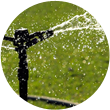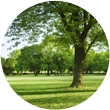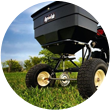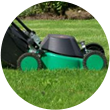Speare Seeds Tips for a Healthy Lawn

Overseeding your lawn every year will help thicken and improve the appearance of your lawn and is the best way to fight weeds.
- If your lawn is thin and patchy, overseeding is the best way to fill these bare spots.
Seed germinates best when soil temperatures are 10-18°C or higher for one week.
Water seed consistently for 14 days after planting.
- Best time to water your lawn is early in the morning
- Avoid puddles of water when watering
- Never allow the soil where the seed is planted to dry out
Initial growth of the seedlings should take place between 10 and 14 days providing there is adequate moisture and soil temperature is ideal.
Seed cannot germinate without seed to soil contact.
- Rake the soil surface before applying seed
- Avoid burying the seed too deeply
- Spread the seed evenly
 Mowing: Set your mower on one of the higher settings. Your grass will respond by growing deeper roots to match the increased top growth. Never cut more than one-third of the grass blade during any one mowing.
Mowing: Set your mower on one of the higher settings. Your grass will respond by growing deeper roots to match the increased top growth. Never cut more than one-third of the grass blade during any one mowing.
Alternate your mowing pattern. Try not to follow the same path each time you mow. Think of a clock. Start at the 12 o'clock position and mow to the 6 o'clock position. The next time you mow, begin at the 9 o'clock position and mow to the to 3 o'clock position. The third time, mow from 1 o'clock to 7 o'clock, etc.

Leave grass clippings on the lawn.
You'll give your lawn valuable nutrients by grinding up the clippings with your mulching mower
You can do the same thing with tree leaves in the fall
And don't worry: grass clippings don't promote thatch.
Weed Control: Control weeds while they're young. The best time to treat troublesome weeds is early in their life cycle. That means applying herbicide to grassy weeds, such as crabgrass, in early spring and to broadleaf weeds, like dandelions, in the fall.
Scout your lawn before mowing and pull weeds by hand when possible.
Fertilizer: Avoid a fertilizer overdose. One pound of water-soluble nitrogen per 1,000 square feet is the maximum amount established lawns should receive at one time. Even good medicine causes harm when used improperly, so avoid doubling the recommended rates of fertilizer as well as seed, herbicide, insecticide, etc. One pound of water-soluble nitrogen per 1,000 square feet is the maximum amount established lawns should receive at one time. Healthy, thick, green lawns that is free of problems.
Watering: Deep watering will grow deep roots. Lawns need one inch of water a week to maintain growth. In absence of rainfall, run sprinklers long enough to put down half an inch of water twice a week. Determine how long to run your sprinklers by measuring the water that accumulates in a rain gauge or drinking glass.
Water early in the day. Watering between 4 a.m. and 9 a.m. helps ensure that the sun won't rob moisture from your lawn. It also gives your lawn the best chance to dry in the morning. Wet grass at night can lead to disease.
Aeration: You can determine if your lawn's roots are being robbed of the air they need by measuring the thatch, the old plant parts that have not decomposed, in your lawn. Remove a plug, square foot of yard, from your lawn to determine if you have more than half an inch of thatch. If there is more than half an inch, your lawn will benefit from a core aeration in early fall.

For thick, green grass that shades out weeds and preserves moisture should be cut at a height of 2.5 to 3 inches. Grass cut shorter is stressed, uses up plant reserves resulting in shallow roots. Only 1/3 of the height should be cut off at one time. Any more taken off causes excess plant stress and uses up excess plant food.
The lawnmower blade should be sharpened every 10 hours. A dull blade makes a ragged cut resulting in brown tips and the plant can lose up to 50% more water than a clean cut. A ragged cut makes the leaves more susceptible to turf diseases.
A healthy lawn with dense grass can actually choke out crabgrass and prevent it from sprouting and taking root, but even a healthy lawn can have a few bare spots that leave a place for crabgrass to take root. The warm weather annual grass is easily propagated through small seeds. These seeds will readily germinate in any open areas of a lawn. The biggest mistake is cutting the lawn too short. Keep lawns cut to 3" - 3.5" in the spring and fall and 4" - 4.5" in the summer. Healthy lawns will choke out the persistent crabgrass plant. Overseeding the lawn with the current species of planted grass will aid in depriving sunlight from the crabgrass seeds. Maintaining a healthy lawn through proper fertilization, watering and mowing will also go a long way in keeping a vigorous growing lawn. Lawns with a high level of health are generally able to keep any errant weeds in check.
Aerate in the late summer or fall when grass will recover quickly and any weed seeds brought up will not germinate or survive the winter.

Water deeply and infrequently
Watering deeply and thoroughly encourages grass to grow deep roots.
This practice especially helps during periods of drought.
Giving your lawn one inch of water every three days is better for the lawn
than watering for a few minutes every day.
Before planning your lawn fertility program, you need to know what it is the yard needs. Have the soil tested first to determine the right type and amount of fertilizer and lime or sulphur required. Additionally, because most lawns in this region have cool grasses, waiting until fall to fertilize is best. Fertilizing in the fall also means less mowing in the spring, improved lawn colour, less weeding, more drought tolerance and development of a better root system.
Fertilizing in the fall also means less mowing in the spring, improved lawn colour, less weeding, more drought tolerance and development of a better root system.

Watering rule - stick a screwdriver shaft into your lawn.
If it goes in easily, your lawn is appropriately moist.
If it is a struggle, you need to water your lawn.

As temps start to cool down and fall is upon us, we are into the best time of year to establish turf as soil temperatures become ideal for new seed establishment. The first step you should take is to mow the grass down low without scalping and remove the clippings. Having short grass will allow the seed to find the holes after aeration. Seed to soil contact is crucial for the seed to germinate. At this time you can either slice or core aerate to open the soil allowing air, water and nutrients into the soil. You should either remove the cores or drag them in. Now that you have the holes open you are ready to overseed. Fall is a great time to establish a good foundation of Kentucky Bluegrass as weed competition is a lot lower now than it is in the Spring. This can allow the bluegrass the time it needs to fill in. It is also a great time to establish a great Turf Type Tall Fescue base if irrigation is not present. Use the recommended overseed rate for whatever species you are trying to establish. Once the seed is in the ground, you should apply a starter fertilizer to hasten seed establishment as well as root development on the existing grass. Based on soil report results, it could also be necessary to make an application of lime to adjust pH and soil conditions.

Weed control is also more effective in the fall especially as the first frost approaches.
The waxy coating on a lot of broadleaf weeds like ground ivy can be penetrated and the weed can be controlled.
Seeding your yard this fall will help keep weeds & bare sports away come Spring!
 Although many homeowners focus on the basics like mowing and fertilizing, the one key care component that is often overlooked is the constant reintroduction of seed (overseeding).
Although many homeowners focus on the basics like mowing and fertilizing, the one key care component that is often overlooked is the constant reintroduction of seed (overseeding).

The steady intro of new turfgrass plants
may be one of the most important practices in the
overall management of a healthy and vigorous home lawn.

Mowing grass is like paying taxes:
It doesn't work to neglect them and hope they'll go away.
Delay only causes taxes and clippings to pile up.
And if you put them off long enough, both can become so massive they're virtually overwhelming.
With those delightful thoughts in mind, let me say that there is no direct way to reduce your mowing. You can’t simply ignore it or decide today to mow less often. The grass just keeps on growing, with or without your help.
So, how do you reduce mowing? Is mowing frequency something the grass dictates and we have no control over?
The only proven way to reduce mowing is to limit the things that induce grass growth in the first place. Nitrogen fertilizer is the most obvious culprit. For every pound of nitrogen you spread on turf per 1000 ft2, you can expect to roughly double the amount of clippings you’ve got to deal with. The more nitrogen you spread, the more you mow.
Fortunately, this relationship also works in reverse. Apply half the nitrogen, and you can expect to harvest about half the hay crop. But it takes time. The fertilizer you’ve been stockpiling in the soil may take weeks or months to dissipate. And until it does, it will continue to feed the grass and generate more clippings. Eventually, though, the rate should slack to something more manageable. When it does, you can use other tricks of the trade to keep your turf attractive. For example, did you know that applications of iron can darken the color of grass without generating clippings?
Nitrogen is not the only means of regulating growth and mowing. There are a number of options open to the progressive turf manager or homeowner. Grass recycling (using a mulching mower), choosing the best height, picking appropriate mowers, plant growth regulators (PGR’s), and a change of grass species are a few of the possibilities open to anyone weary of cutting grass. There are things you can do to reduce mowing.

When is the best time to overseed my lawn?
This is a question that many people ask, & one that is always related to early Spring when the snow melts.
The best time to overseed is late spring or late summer.
If you choose to overseed your lawn only once a year, it is best to overseed your lawn between August 15th and September 15th. Seeds germinate quickly in warm soil, there is less soil erosion from heavy spring rainfalls, any weeds that do germinate are likely to die when the fall frost season starts and it also gives your new seedlings time to “harden off” and prepare themselves for the winter ahead. As your grass awakens in the spring and you still feel the need to overseed, wait until around May 15th so the soil temperatures have a chance to consistently reach 10C to 18C for at least a week. The chances of successful overseeding will greatly improve if you follow these simple overseeding rules.